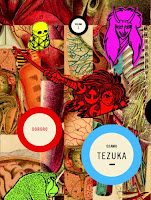 Creator: Osamu Tezuka
Creator: Osamu Tezuka
U.S. publisher: Vertical
ISBN: 9781934287163
Released: April 2008
Original run: 1967-1968
Awards: Eisner Award
Dororo happens to be one of my favorite manga created by Osamu Tezuka, so it made sense to me to review it for February 2012’s Manga Moveable Feast focusing on Tezuka and his work. Dororo was originally serialized in Japan in Shukan Shonen Sunday between 1967 and 1968. Vertical initially published the series in 2008 in three volumes, winning the 2009 Eisner Award for the best U.S. edition of international material from Japan. The individual volumes are now out of print, but Vertical’s omnibus edition will be released in 2012. In 1969, a twenty-six episode anime series based on the manga was created with an ending that provides a little more closure than the original. Dororo was also the inspiration for the 2004 PlayStation 2 video game Blood Will Tell. A live-action film adaptation of Dororo was released in 2007 and was very well received in Japan.
Thirsting for power, Lord Daigo offers the body of his unborn child as a sacrifice to forty-eight demons in exchange for their aid in conquering the country. The child is born missing forty-eight body parts and is abandoned. Rescued and raised by a kindly doctor, Hyakkimaru must eventually set off on his own, hoping to find happiness and to regain his body. Pursued by demons and dead souls, he is shunned by others, leading a lonely existence until he saves the life of Dororo, a young thief who is similarly reviled. Dororo, like Hyakkimaru, is also hiding a tragic past, but is surprisingly resilient and stubborn. Although Hyakkimaru is initially reluctant, the two being traveling the war-torn countryside together. Moving from village to village and confronting monsters and demons along the way, the two have each other and not much else.
Tezuka’s artwork in Dororo is wonderully cinematic and has excellent pacing. The battles and sword fights are varied and exciting; the demons and spirits Hyakkimaru must face are monstrous and terrifying. Although Tezuka’s style is somewhat cartoonish, the art can actually be quite gruesome. Occasionally the action isn’t entirely clear, but the overall effect is very engaging. Tezuka isn’t afraid to use extended moments without dialogue as Hyakkimaru and Dororo wander through the country. More emphasis is given to backgrounds and landscapes than in some of Tezuka’s earlier works, granting Dororo a solid sense of place. Tezuka draws visual cues and plot elements from samurai films and stories as well as from traditional Japanese folklore, legends, and tales. Mixing these elements together with his own ideas and thematic sensibilities, Dororo is a series that is uniquely Tezuka. The two downtrodden leads, carrying on with their lives under adverse and less than ideal circumstances, are very likeable and it is fascinating to watch their relationship develop.
If there is one thing that annoys me about the first volume of Dororo it’s that early on several characters make comments about dump trucks, space aliens, cyborgs and such which really threw me out of the story and setting. In many ways, Dororo can be seen as a transitional series, a bridge between Tezuka’s earlier and later works that expanded his audience and introduced darker themes and darker protagonists. Hyakkimaru, with his fancy prosthetics and gadgets, could be a feudal era Astro Boy but is even more closely related to and serves as a prototype for Tezuka’s later character and fan favorite Black Jack. While this is certainly interesting, personally I love Hyakkimaru for being Hyakkimaru. He is a complex character; cynical and world-weary, he continues to fight on despite persecution from demons and humans alike. I have reread Dororo several times now and I still love the series as much as I did the fist time and maybe even more. Tezuka is a phenomenal storyteller.

Speak Your Mind